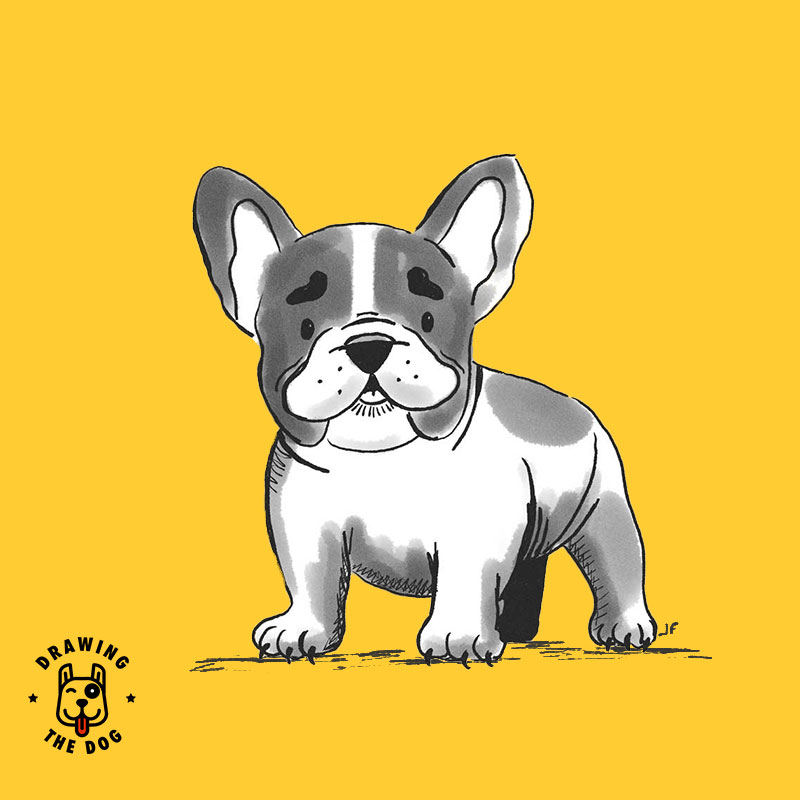French Bulldogs 101- A Guide To Frenchies
French Bulldogs 101 :
The Fascinating World of Frenchies

Introduction to French Bulldogs
French Bulldogs, affectionately known as “Frenchies,” have surged in popularity over the past few decades, becoming one of the most beloved dog breeds in the world. Their charming personalities, compact size, and distinctive bat-like ears make them instantly recognizable and endearing to dog lovers everywhere. As a breed, French Bulldogs are known for their affectionate nature, making them excellent companions for families, singles, and seniors alike.
One of the most appealing aspects of French Bulldogs is their adaptability. They thrive in various living situations, from apartments to larger homes, and they require less exercise than many other breeds, making them ideal for urban living. Their playful yet calm demeanor allows them to fit seamlessly into various lifestyles, whether you’re a busy professional or a stay-at-home parent.
However, owning a French Bulldog comes with its own set of responsibilities and considerations. Understanding their unique needs, health concerns, and personality traits is crucial for prospective owners. This guide aims to provide a comprehensive overview of everything you need to know about French Bulldogs, ensuring that you are well-prepared to welcome one into your home.
In this guide, we will explore the history and origins of the breed, their physical characteristics, temperament, health considerations, training tips, exercise needs, grooming requirements, and dietary needs. Additionally, we will touch on how to celebrate your love for French Bulldogs through wall art and other creative expressions.
French Bulldog Quick Facts
- Group: Non-sporting
- Height: 280–305 mm (11–12 inches)
- Weight: 7–13 kg (16–28 lbs)
- Coat: Short, smooth, and fine
- Coat Colours: Brindle, fawn, pied; rare colors include blue and chocolate
- Life Span: 10–12 years
- Temperament: Affectionate, playful, sociable
- Country of Origin: England/France
Looking for the perfect French Bulldog-inspired artwork for your home?
Check out our unique collection of wall art and prints, celebrating this lovable breed!
History and Origins of the French Bulldog
The French Bulldog’s history is as fascinating as the breed itself. Originating in England in the early 19th century, the breed was initially developed as a smaller version of the English Bulldog. Lace workers in Nottingham bred these small dogs to serve as companions and ratters in their homes. As the Industrial Revolution progressed, many of these workers migrated to France, bringing their beloved dogs with them.
In France, the breed gained popularity among the upper class and was further refined. The French began to breed these dogs for their unique characteristics, such as their distinctive bat ears and playful demeanor. By the late 1800s, the French Bulldog was officially recognized as a distinct breed, and it quickly became a favorite among Parisian society.
The breed’s popularity continued to grow, and by the early 20th century, French Bulldogs were being showcased in dog shows across Europe and the United States. Their charming personalities and unique appearance captured the hearts of many, leading to their rise as one of the most sought-after companion breeds. Today, French Bulldogs are not only popular pets but also cultural icons, often seen in movies, social media, and even fashion.
Understanding the history of the French Bulldog provides valuable context for their behavior and characteristics. Their evolution from working dogs to beloved companions highlights their adaptability and the strong bond they form with humans.
Physical Characteristics: Size, Coat, and Color
French Bulldogs are small but sturdy dogs, typically weighing between 16 to 28 pounds and standing about 11 to 12 inches tall at the shoulder. Their compact size makes them ideal for various living situations, including apartments and smaller homes. Despite their small stature, they possess a muscular build, giving them a robust appearance.
One of the most distinctive features of French Bulldogs is their coat. They have a short, smooth coat that is easy to maintain, requiring minimal grooming. This breed comes in a variety of colors, including brindle, fawn, white, and combinations of these colors. The diversity in coat color adds to their appeal, allowing owners to choose a Frenchie that matches their personal style.
French Bulldogs also have unique facial features, including a short snout and prominent, rounded eyes. These characteristics contribute to their expressive faces, which can convey a wide range of emotions. However, these physical traits also make them prone to certain health issues, particularly respiratory problems, due to their brachycephalic (short-nosed) structure.
Overall, the physical characteristics of French Bulldogs contribute to their charm and appeal. Their compact size, unique coat colors, and expressive faces make them stand out in a crowd, while their sturdy build ensures they can keep up with their owners’ lifestyles.
Temperament and Personality Traits of French Bulldogs
French Bulldogs are known for their affectionate and playful nature. They thrive on human interaction and are often described as “people-oriented” dogs. This breed is known for forming strong bonds with their owners, often following them around the house and seeking attention and companionship. Their friendly demeanor makes them excellent family pets, as they typically get along well with children and other animals.
Despite their playful nature, French Bulldogs can also exhibit stubbornness. This trait can make training a bit challenging at times, as they may not always be eager to follow commands. However, with consistent and positive reinforcement training methods, owners can successfully teach their Frenchies basic commands and tricks. Socialization is also crucial for this breed, as it helps them develop confidence and reduces the likelihood of behavioral issues.
French Bulldogs are known for their quirky personalities, often displaying a sense of humor that endears them to their owners. They can be quite entertaining, with their playful antics and unique vocalizations. Many Frenchies are known to “talk” or make amusing sounds, adding to their charm and making them delightful companions.
In summary, the temperament and personality traits of French Bulldogs make them exceptional companions. Their affectionate nature, playful spirit, and quirky personalities create a strong bond with their owners, making them a joy to have in any household.
Health Considerations: Common Issues and Lifespan
While French Bulldogs are beloved for their charming personalities, they are also prone to certain health issues that potential owners should be aware of. One of the most significant concerns is their brachycephalic nature, which can lead to respiratory problems. Conditions such as brachycephalic obstructive airway syndrome (BOAS) can cause difficulty breathing, especially in hot or humid weather. Owners should be vigilant about monitoring their Frenchie’s breathing and avoiding strenuous exercise during extreme temperatures.
In addition to respiratory issues, French Bulldogs are also susceptible to skin problems, hip dysplasia, and eye conditions such as cataracts and cherry eye. Regular veterinary check-ups are essential to catch any potential health issues early and ensure your Frenchie remains healthy. It’s also important to maintain a healthy weight, as obesity can exacerbate many health problems in this breed.
The average lifespan of a French Bulldog is around 10 to 12 years, although some can live longer with proper care. Providing a balanced diet, regular exercise, and routine veterinary care can significantly impact your Frenchie’s overall health and longevity. Being proactive about their health can help you enjoy many happy years together.
In conclusion, while French Bulldogs are generally healthy dogs, they do have specific health considerations that potential owners should be aware of. Understanding these issues and taking preventive measures can help ensure a long and happy life for your Frenchie.
Training and Socialization Tips for French Bulldogs
Training and socialization are crucial components of raising a well-adjusted French Bulldog. Due to their stubborn nature, training may require patience and consistency. Positive reinforcement techniques, such as treats and praise, are highly effective in motivating Frenchies to learn. Start with basic commands like “sit,” “stay,” and “come,” gradually increasing the complexity of the training as your dog becomes more comfortable.
Socialization is equally important for French Bulldogs. Exposing them to various environments, people, and other animals from a young age helps them develop confidence and reduces the likelihood of behavioral issues. Consider enrolling your Frenchie in puppy classes or arranging playdates with other dogs to facilitate socialization. The more experiences they have, the better equipped they will be to handle new situations.
Consistency is key when training a French Bulldog. Establish a routine for training sessions and stick to it. Short, frequent training sessions are often more effective than longer ones, as Frenchies can become easily distracted. Incorporating play into training can also make the process more enjoyable for both you and your dog.
Lastly, be patient and understanding. French Bulldogs may not always respond immediately to commands, but with time and persistence, they can learn and thrive. Building a strong bond through training and socialization will lead to a well-behaved and happy Frenchie.
Exercise Needs: Keeping Your French Bulldog Active and Happy
While French Bulldogs are not as high-energy as some other breeds, they still require regular exercise to maintain their physical and mental well-being. Daily walks, playtime, and interactive games are essential for keeping your Frenchie happy and healthy. Aim for at least 30 minutes of exercise each day, but be mindful of their limitations due to their brachycephalic nature.
Short walks are ideal for French Bulldogs, as they can tire easily. Be cautious during hot or humid weather, as they are prone to overheating. It’s essential to monitor their breathing during exercise and provide plenty of water breaks. If your Frenchie shows signs of fatigue or distress, it’s best to cut the exercise short and allow them to rest.
In addition to walks, engaging your Frenchie in playtime can help satisfy their exercise needs. Interactive toys, fetch games, and puzzle toys can stimulate their minds and keep them entertained. French Bulldogs are known for their playful nature, so incorporating play into their daily routine can strengthen your bond and provide them with the physical activity they need.
Overall, while French Bulldogs may not require extensive exercise, regular physical activity is crucial for their health and happiness. By providing daily walks and engaging playtime, you can ensure your Frenchie remains active and content.
Grooming Requirements: Maintaining a Healthy Coat
One of the advantages of owning a French Bulldog is their low grooming requirements. Their short, smooth coat requires minimal maintenance compared to long-haired breeds. Regular brushing, about once a week, is sufficient to remove loose hair and keep their coat looking healthy. This simple grooming routine helps reduce shedding and keeps your home cleaner.
In addition to brushing, it’s essential to pay attention to your Frenchie’s skin folds. French Bulldogs have prominent skin folds around their face, which can trap moisture and debris. Regularly cleaning these folds with a damp cloth can help prevent skin infections and irritation. Be gentle when cleaning, as their skin can be sensitive.
Bathing your French Bulldog should be done as needed, typically every few months or when they become particularly dirty. Use a mild dog shampoo to avoid irritating their skin. After bathing, ensure they are thoroughly dried, especially in the skin folds, to prevent moisture buildup.
Overall, maintaining a healthy coat for your French Bulldog is relatively easy. With regular brushing, skin fold care, and occasional baths, you can keep your Frenchie looking and feeling their best.
Nutrition and Diet: Feeding Your French Bulldog
Proper nutrition is vital for the health and well-being of your French Bulldog. A balanced diet tailored to their specific needs can help prevent obesity and other health issues. When selecting dog food, look for high-quality options that list meat as the primary ingredient. Avoid foods with excessive fillers, artificial additives, or low-quality ingredients.
Portion control is essential for French Bulldogs, as they are prone to weight gain. Follow the feeding guidelines on the dog food packaging, but be prepared to adjust based on your dog’s activity level and individual needs. It’s also a good idea to consult with your veterinarian for personalized dietary recommendations.
In addition to commercial dog food, you may consider incorporating fresh fruits and vegetables into your Frenchie’s diet as healthy treats. Foods like carrots, blueberries, and green beans can provide essential nutrients without adding excessive calories. However, always research which human foods are safe for dogs before introducing them to your Frenchie’s diet.
Lastly, ensure your French Bulldog has access to fresh water at all times. Hydration is crucial for their overall health, especially during exercise or hot weather. By providing a balanced diet and monitoring their food intake, you can help your Frenchie maintain a healthy weight and enjoy a long, happy life.
Wall Art For French Bulldog Lovers
For those who adore French Bulldogs, expressing that love through art can be a fun way to celebrate this charming breed. Wall art featuring French Bulldogs can add a personal touch to your home decor while showcasing your passion for these lovable companions. From whimsical illustrations to elegant portraits, there are countless options available to suit various tastes and styles. Check out some of my French Bulldog prints below.
Art Prints For French Bulldog Lovers
-
French Bulldog – Captain Frenchie Art Print
€35.00 -
French Bulldog – Dr. Frenchie Will See You Now Art Print
€25.00 – €35.00 -
French Bulldog Appreciation Society Art Print (Black & White Frenchie)
€25.00 – €35.00 -
French Bulldog Appreciation Society Art Print (Cream Frenchie)
€25.00 – €35.00 -
French Bulldog Appreciation Society Art Print (Fawn Frenchie)
€25.00 – €35.00 -
French Bulldog Appreciation Society Wall Art (Pied Frenchie)
€25.00 – €35.00 -
French Bulldog Bauhaus-Inspired Wall Art
€25.00 – €35.00 -
French Bulldog Diagonal Stripes Wall Art
€25.00 – €35.00
Conclusion: Why the French Bulldog Makes a Great Companion
In conclusion, French Bulldogs are more than just adorable pets; they are loyal companions that bring joy and love into our lives. Their affectionate nature, playful personalities, and adaptability make them ideal for various living situations and lifestyles. While they do have specific health considerations and grooming needs, the rewards of owning a French Bulldog far outweigh the challenges.
Their unique history and charming physical characteristics add to their appeal, making them a favorite among dog lovers worldwide. With proper training, socialization, and care, French Bulldogs can thrive in any environment, forming strong bonds with their owners and





















